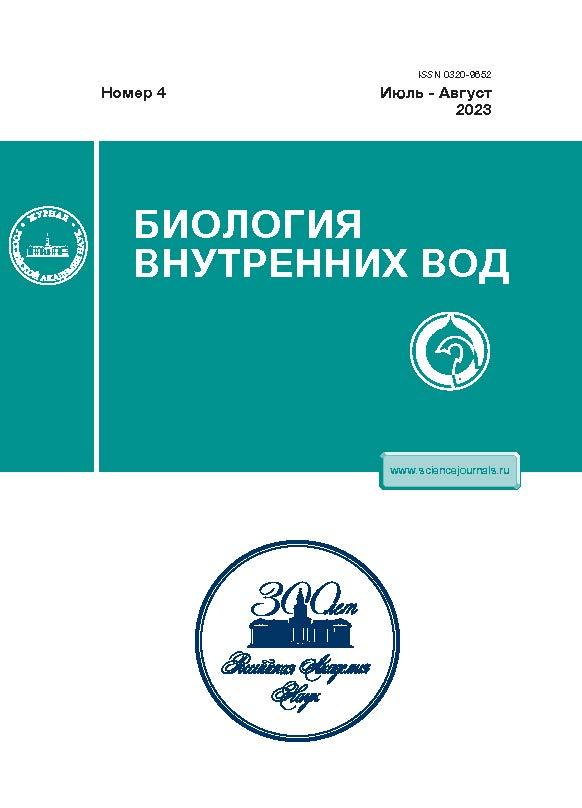Distribution of Topmouth Gudgeon Pseudorasbora parva (Cyprinidae) in Waterbodies and Watercourses of Republic of Dagestan, Russia
- Authors: Barkhalov R.M.1,2, Stolbunov I.A.3, Artaev O.N.3, Turbanov I.S.3,4, Rabazanov N.I.1, Khlopkova M.V.1, Karabanov D.P.3
-
Affiliations:
- Caspian Institute of Biological Resources, Dagestan Federal Research Center, Russian Academy of Sciences
- State Nature Reserve “Dagestansky”
- Papanin Institute for Biology of Inland Waters Russian Academy of Sciences
- Cherepovets State University
- Issue: No 4 (2023)
- Pages: 563-569
- Section: КРАТКИЕ СООБЩЕНИЯ
- URL: https://journals.rcsi.science/0320-9652/article/view/134929
- DOI: https://doi.org/10.31857/S0320965223040046
- EDN: https://elibrary.ru/RVNRHR
- ID: 134929
Cite item
Abstract
The study provides information on the modern distribution of a species alien to the ichthyofauna of Republic of Dagestan, topmouth gudgeon Pseudorasbora parva (Temminck et Schlegel, 1846) (Cyprinidae). It has been established that this species is found in the rivers Manasozen, Gamriozen, Ulluchay, Rubas, Avar Koisu (a tributary of the Sulak River, in the area of the Gotsatlinskaya HPP), as well as in Lake Mochokh. The wide distribution of P. parva is associated with ecological plasticity, migratory activity, high growth rate, accelerated puberty and high level of survival of the offspring of this species of fish.
About the authors
R. M. Barkhalov
Caspian Institute of Biological Resources, Dagestan Federal Research Center, Russian Academy of Sciences; State Nature Reserve “Dagestansky”
Author for correspondence.
Email: barkhalov.ruslan@yandex.ru
Russia, Makhachkala; Russia, Makhachkala
I. A. Stolbunov
Papanin Institute for Biology of Inland Waters Russian Academy of Sciences
Author for correspondence.
Email: sia_borok@mail.ru
Russia, Nekouzskii raion, Yaroslavl oblast, Borok
O. N. Artaev
Papanin Institute for Biology of Inland Waters Russian Academy of Sciences
Email: sia_borok@mail.ru
Russia, Nekouzskii raion, Yaroslavl oblast, Borok
I. S. Turbanov
Papanin Institute for Biology of Inland Waters Russian Academy of Sciences; Cherepovets State University
Email: sia_borok@mail.ru
Russia, Nekouzskii raion, Yaroslavl oblast, Borok; Russia, Cherepovets
N. I. Rabazanov
Caspian Institute of Biological Resources, Dagestan Federal Research Center, Russian Academy of Sciences
Email: sia_borok@mail.ru
Russia, Makhachkala
M. V. Khlopkova
Caspian Institute of Biological Resources, Dagestan Federal Research Center, Russian Academy of Sciences
Email: sia_borok@mail.ru
Russia, Makhachkala
D. P. Karabanov
Papanin Institute for Biology of Inland Waters Russian Academy of Sciences
Email: sia_borok@mail.ru
Russia, Nekouzskii raion, Yaroslavl oblast, Borok
References
- Абдусамадов А.С., Абдурахманов Г.М., Карпюк М.И. 2004. Современное состояние и эколого-экономические перспективы развития рыбного хозяйства в Западно-Каспийском регионе России. М.: Наука.
- Богуцкая Н.Г., Кудерский Л.А., Насека А.М., Сподарева В.В. 2004. Пресноводные рыбы России за пределами исторических ареалов: обзор типов интродукций и инвазий // Биологические инвазии в водных и наземных экосистемах. М.: Тов-во науч. изданий КМК.
- Дгебуадзе Ю.Ю., Петросян В.Г., Хляп Л.А. 2018. Самые опасные инвазионные виды России (ТОП-100). М.: Тов-во науч. изданий КМК.
- Карабанов Д.П., Кодухова Ю.В. 2015. Распространение амурского чебачка Pseudorasbora parva (Actinopterygii: Cyprinidae) в водоемах Кавказа // Экол. вест. Сев. Кавказа. Т. 11. № 2. С. 55.
- Кудерский Л.А. 2001. Акклиматизация рыб в водоемах России: состояние и пути развития // Вопр. рыболовства. Т. 2. № 1. С. 6.
- Мовчан Ю.В. 2011. Риби України (визначник-довідник). Київ: Золоті ворота.
- Никольский Г.В. 1956. Рыбы бассейна Амура. Итоги Амурской ихтиологической экспедиции 1945–1949. М.: Изд-во АН СССР.
- Пашков А.Н., Плотников Г.К., Шутов И.В. 2004. Новые данные о составе и распространении видов – акклиматизантов в ихтиоценозах континентальных водоемов Северо-Западного Кавказа // Изв. ВУЗов. Северо-Кавказский регион. № S1. С. 46.
- Правдин И.Ф. 1966. Руководство по изучению рыб (преимущественно пресноводных). М.: Пищ. пром-сть.
- Строганова Н.З. 1994. Результаты и проблемы акклиматизации гидробионтов // Рыбоводство и рыболовство. № 3. С. 10.
- Хатухов А.М., Шахмурзов М.М. 1996. Ихтиофауна бассейна реки Терек // Рыбоводство и рыболовство. № 1. С. 17.
- Britton J.R. 2022. Contemporary perspectives on the ecological impacts of invasive freshwater fishes // J. Fish Biol. V. 101. P. 15240. https://doi.org/10.1111/jfb.15240
- Carosi A., Ghetti L., Lorenzoni M. 2021. The role of climate changes in the spread of freshwater fishes: implications for alien cool and warm-water species in a Mediterranean Basin // Water. V. 13. P. 347. https://doi.org/10.3390/w13030347
- Combe M., Cherif E., Charrier A. et al. 2022. Towards unravelling the Rosette agent enigma: Spread and emergence of the co-invasive host-pathogen complex, Pseudorasbora parva – Sphaerothecum destruens // The Science of the Total Environment. V. 806. № Pt2. 150427. https://doi.org/10.1016/j.scitotenv.2021.150427
- Karabanov D.P., Kodukhova Yu.V., Slyn’ko Yu.V. 2010. New finds of topmouth gudgeon Pseudorasbora parva (Temm. et Schl., 1846) in the European Part of Russia // Rus. J. Biol. Invasions. V.1. № 3. P. 156. https://doi.org/10.1134/S2075111710030021
- Karabanov D.P., Kodukhova Y.V., Pashkov A.N. et al. 2021. “Journey to the West”: Three phylogenetic lineages contributed to the invasion of Stone moroko, Pseudorasbora parva (Actinopterygii: Cyprinidae) // Rus. J. Biol. Invasions. V. 12. № 1. P. 67. https://doi.org/10.1134/S2075111721010070
- Lemmens P., Mergeay J., Vanhove T. et al. 2015. Suppression of invasive topmouth gudgeon Pseudorasbora parva by native pike Esox lucius in ponds // Aquat. Conserv. V. 25. № 1. P. 41. https://doi.org/10.1002/aqc.2479
- Nentwig W., Bacher S., Kumschick S. et al. 2018. More than “100 worst” alien species in Europe // Biol. Invasions. V. 20. № 6. P. 1611. https://doi.org/10.1007/s10530-017-1651-6
- Rabazanov N.I., Barkhalov R.M., Rabazanov R.N., Markevich G.N. 2022. State of the population of Kezenoi-Am Trout (Salmo trutta ezenami Berg, 1948) and the forecast of the development of the ecological situation in lake Kezenoi-Am // Arid Ecosystems. V. 12. № 1. P. 113. https://doi.org/10.1134/S2079096122010085
- Starsev A.V., Korchunov A.A., Rabazanov N.I., Rabazanov R.N. 2019. Ecology and distribution of the Amur Chebachok Pseudorasbora parva (Temminck et Schlegel, 1846) as a biologically invasive species in the delta and estuarine coast of the river Don // South of Russia: ecology, development. V. 14. № 3. P. 6. https://doi.org/10.18470/1992-1098-2019-3-6-16
- Rosecchi E., Crivelli A.J., Catsadorakis G. 1993. The establishment and impact of Pseudorasbora parva, an exotic fish species introduced into Lake Mikri Prespa (north-western Greece) // Aquat. Conserv. V. 3. P. 223. https://doi.org/10.1002/aqc.3270030306
- Zanden M.J.V., Lapointe N.W.R., Marchetti M.P. 2015. Non-indigenous fishes and their role in freshwater fish imperilment // Conservation of Freshwater Fishes. Cambridge: Cambridge Univ. Press. P. 238. https://doi.org/10.1017/CBO9781139627085.009








